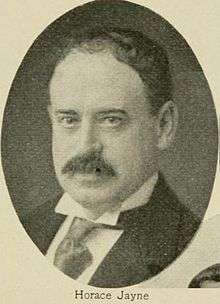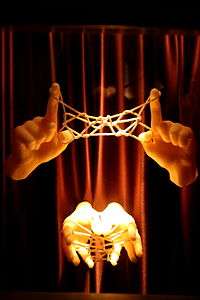Caroline Furness Jayne
Caroline Augusta Furness Jayne (July 3, 1873 – June 23, 1909) was an American ethnologist. She wrote the best-known book on string figures, String Figures and How to Make Them: a study of cat's cradle in many lands, 1906.
Caroline Furness Jayne | |
|---|---|
_portrait_by_William_Merritt_Chase.jpg) Portrait by William Merritt Chase | |
| Born | 3 July 1873 |
| Died | 23 June 1909 |
| Occupation | Ethnologist |
Biography
Jayne was the youngest of the four children (and only daughter) of Shakespearean scholar Horace Howard Furness and author Helen Kate (Rogers) Furness. She grew up in the family's Philadelphia city house, facing Washington Square, and their summer house in Wallingford, Pennsylvania. She graduated from the Agnes Irwin School. On October 10, 1894, she married Horace Jayne, a biology professor at the University of Pennsylvania.[1]
String figures
Jayne's string figure mentor was Alfred Haddon, a Cambridge ethnologist who began the introduction to her book by noting that "in ethnology ... nothing is too insignificant to receive attention". He then goes on to defend the research invested in the unpromising amusement of string figures.[2] Jayne, an extensive traveler herself, was the first to create a popular study of string figures building on dry academic papers which had appeared in journals like The Annual Report of the Bureau of Ethnology and the Proceedings of the Royal Geographical Society as well as in a variety of foreign language anthropological journals. (These are listed in her Bibliography (pp. 396-98) and include papers by Dr Haddon (six) and 42 other researchers.)
String Figures and How to Make Them was first published in 1906 by Charles Scribner's Sons, New York (ISBN 0-8446-2318-0), and was reprinted by Dover Publications, New York in 1962 (LCCN: 62-51880); later reissues have ISBNs 0-613-81171-2 and 0-486-20152-X. It included figures illustrating every game and 16 portraits of players. Jayne's brother, ethnographer William Henry Furness III, provided some of the illustrations for the book.
Whew! Five-dollar cat's-cradles! Several full-page pictures and 934 other illustrations of cat's-cradles and other string figures. One is appalled at any attempt at description of such a book, so simple and yet so complex, so slight in its purpose, so vast in its revelation, and when one has gone through these more than 400 pages and nearly a thousand pictures he learns that all of this is merely "an introduction," to a real study of string figures—games which are widespread among primitive peoples, and played by weaving on the hands a single loop of string in order to produce intricat patterns supposed to represent certain familiar objects. All that is known of cat's-cradle figures in all lands and times is here gathered together with numerous studies, historic and ingenious. While there is in this a purpose to inspire the collector's craze of cat's-cradle curiosities in all races and places, there is a higher purpose of interesting people in the fascination of these games that quicken intellectual activities along a different line from bridge whist, games in which young and old alike can participate.
— 1906 review from the Journal of Education[3]
Personal
The Jaynes had two children, Kate Furness Jayne (b. 1895) and Horace H. F. Jayne (b. 1898).
They built a Philadelphia city house at 19th & Delancey Streets, designed by her uncle, the architect Frank Furness. They built a summer house in Wallingford, Pennsylvania, "Sub Rosa" (also designed by her uncle), on the grounds of her father's summer house. Following Jayne's early death at age 36, her husband and children lived year-round at "Sub Rosa".
In her memory, her father commissioned a Tiffany window for the First Unitarian Church of Philadelphia. The window features a portrait of her holding a lily.[4]
Her friend, the poet Florence Earle Coates, wrote a poem in her memory (link below).
Her son, Horace H. F. Jayne, became the first curator of Chinese art at the Philadelphia Museum of Art, and later was director of the University of Pennsylvania Museum of Archaeology and Anthropology and vice director of the Metropolitan Museum of Art.
_p333.jpg) "Dr. Furness's House, West Washington Square, just before it was torn down." (1914), Joseph Pennell
"Dr. Furness's House, West Washington Square, just before it was torn down." (1914), Joseph Pennell Horace Jayne, in 1899
Horace Jayne, in 1899- Horace Jayne House, Philadelphia, PA (1895), Frank Furness, architect
- "Sub Rosa" (c.1896, demolished), Wallingford, PA, Frank Furness, architect
References
- "Horace Jayne," Who's Who in America (Chicago: A. N. Marquis & Company, 1911), p. 1009.
- Haddon "Introduction" in Jayne, C. F. (1906); pp. xi-xxiii
- Boston University (April 12, 1906). Journal of Education, Volumes 63-64, p.413. Boston University: School of Education.
- Our Building. from First Unitarian Church of Philadelphia.
External links

| Wikimedia Commons has media related to String Figures and How to Make Them. |
- Caroline Furness Jayne at Find a Grave
- Caroline Furness Jayne (1873-1909)
- Coates, Florence Earle (1909). – via Wikisource.
